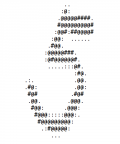Welcome
I am a research scientist with broad interests in machine learning and artificial intelligence. My work on large scale learning and stochastic gradient algorithms has received attention in the recent years. I am also known for the DjVu document compression system. I joined Facebook AI Research in March 2015.
Use the sidebar to navigate this site.
News
The infinite MNIST dataset
 Why settle for 60000 MNIST training examples when you can have one trillion?
The MNIST8M dataset was generated using the elastic deformation code originally written
for (Loosli, Canu, and Bottou, 2007). Unfortunately the
original MNIST8M files were accidentally deleted from the NEC servers a couple weeks ago.
Instead of regenerating the files, I have repackaged the generation code in
a convenient form.
Why settle for 60000 MNIST training examples when you can have one trillion?
The MNIST8M dataset was generated using the elastic deformation code originally written
for (Loosli, Canu, and Bottou, 2007). Unfortunately the
original MNIST8M files were accidentally deleted from the NEC servers a couple weeks ago.
Instead of regenerating the files, I have repackaged the generation code in
a convenient form.
Explore/Exploit = Correlation/Causation!
 Our paper“Counterfactual Reasoning and Learning Systems: The Example of Computational Advertising” has appeared in JMLR. This paper takes the example of ad placement to illustrate how one can leverage causal inference to understand the behavior of complex learning systems interacting with their environment.
Our paper“Counterfactual Reasoning and Learning Systems: The Example of Computational Advertising” has appeared in JMLR. This paper takes the example of ad placement to illustrate how one can leverage causal inference to understand the behavior of complex learning systems interacting with their environment.
Nips 2013
 Nips just took place near Lake Tahoe.
Many people have written how things are changing in machine learning.
There also were many interesting papers and invited talks.
Thanks to the program chairs Max and Zoubin for producing this exciting conference program.
Thanks to the workshop chairs Rich Caruana and Gunnar Rätsch for the stimulating workshops.
Thanks to Terry Sejnowsky for creating NIPS,
and special thanks to Mary-Ellen Perry without whom nothing would happen.
Nips just took place near Lake Tahoe.
Many people have written how things are changing in machine learning.
There also were many interesting papers and invited talks.
Thanks to the program chairs Max and Zoubin for producing this exciting conference program.
Thanks to the workshop chairs Rich Caruana and Gunnar Rätsch for the stimulating workshops.
Thanks to Terry Sejnowsky for creating NIPS,
and special thanks to Mary-Ellen Perry without whom nothing would happen.
Counterfactual Reasoning and Learning Systems
The report “Counterfactual Reasoning and Learning Systems” shows how to leverage causal inference to understand the behavior of complex learning systems interacting with their environment and predict the consequences of changes to the system. Such predictions allow both humans and algorithms to select changes that improve both the short-term and long-term performance of such systems. This work is illustrated by experiments carried out on the ad placement system associated with the Bing search engine.
